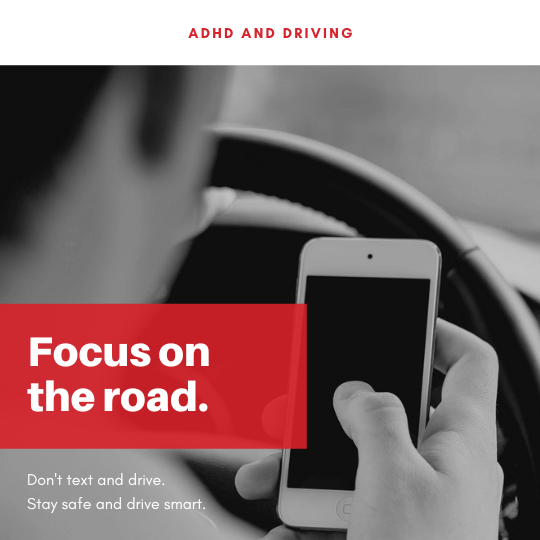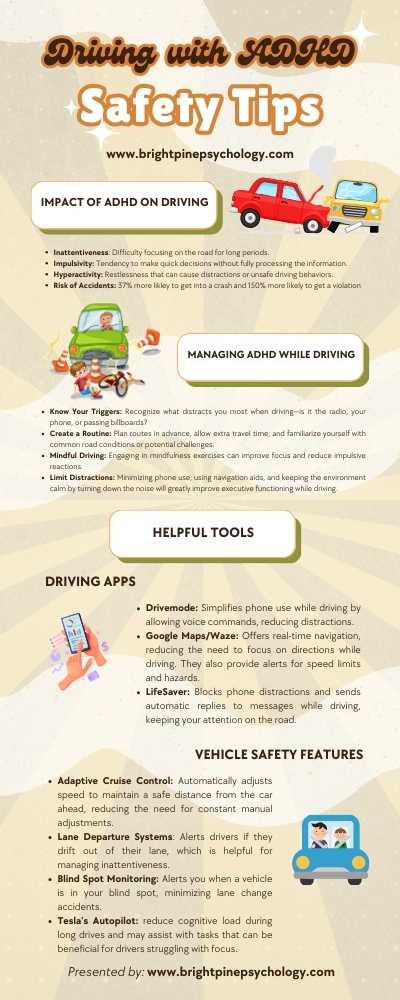ADHD and Driving: Understanding the Impact of Attention Deficits on the Road

Table of Contents
As a mental health professional and a mom, I’ve seen firsthand how ADHD affects various aspects of life, including one that often goes overlooked: driving. While the challenges of ADHD are frequently discussed in academic settings or during therapy sessions, understanding how it translates into daily activities—like getting behind the wheel—can make a significant difference for those living with it, as well as for their families.
Driving is a complex task that requires a combination of focus, quick decision-making, and sustained attention, all areas where individuals with ADHD may struggle. For parents, educators, and healthcare providers, it’s essential to recognize how ADHD can influence driving habits and how to equip young drivers—and even adults—with the right tools to ensure safety on the road.
The Connection Between ADHD and Driving
Driving isn’t just about knowing the rules of the road; it’s about managing the constant flow of information and reacting quickly to changing conditions. For someone with ADHD, this can be especially overwhelming. ADHD, characterized by symptoms of inattention, impulsivity, and hyperactivity, makes it harder for individuals to maintain concentration during monotonous activities, such as long stretches of highway driving, or manage sudden changes, like a child darting across the street.
Research has consistently shown that drivers with ADHD are at a higher risk of accidents compared to their neurotypical peers. A study by Barkley et al. (2006) found that drivers with ADHD are two to four times more likely to be involved in car crashes. This is because ADHD impacts the cognitive skills needed to manage complex tasks, including staying aware of traffic, keeping track of speed, and adjusting to unexpected situations.
As a mom, this hits close to home. Watching my own children develop independence is exciting, but it also comes with the realization that they will one day be responsible for their own safety—and the safety of others—while driving. For those with ADHD, that transition can feel daunting, but it doesn’t have to be overwhelming if approached thoughtfully.
How ADHD Affects Driving
Inattention
People with ADHD often have difficulty sustaining attention for long periods. This is a challenge when driving, where focus needs to be continuous. It’s easy to lose focus when the road seems endless or repetitive. Inattention may lead to missed stop signs, running red lights, or failing to notice changes in traffic patterns. Drivers with ADHD might find themselves “zoning out,” only to snap back and realize they’ve missed something critical.
Impulsivity
Impulsivity can make it difficult for ADHD drivers to resist acting on sudden urges. This could manifest as speeding, changing lanes without signaling, or making risky moves in traffic, such as darting out from a stop sign without fully gauging the flow of vehicles. The need for immediate action can override the thoughtful deliberation necessary for safe driving.
Hyperactivity
While hyperactivity might not always look like bouncing off the walls, it can still manifest as restlessness behind the wheel. Fidgeting, adjusting the radio repeatedly, or frequently shifting positions can distract the driver from focusing on the road. This sense of constant motion makes it hard to maintain consistent, safe driving practices.
Difficulty with Executive Functioning
Executive functions—the cognitive processes that allow us to plan, focus, and execute tasks—are often impaired in individuals with ADHD. Driving requires good executive functioning to anticipate what will happen next, make quick decisions, and follow through on those decisions. For instance, being able to anticipate when to slow down for an upcoming exit or manage a sudden change in weather conditions requires planning and flexibility, both of which can be challenging for drivers with ADHD.
Strategies for Safe Driving
While the risks associated with ADHD and driving are real, there are many strategies that can significantly improve safety. As both a mental health professional and a parent, I’ve seen how proactive approaches can make a world of difference. Here are some key strategies:
Medication Management
For individuals who take medication for ADHD, it’s important to ensure that they’re managing their dosages correctly when driving. Medication, particularly stimulants like Adderall or Ritalin, can improve attention and focus, making driving a safer activity. However, it’s also crucial to be aware of how medication affects alertness, especially when dealing with drowsiness during longer drives.
Creating a Distraction-Free Environment
Removing distractions from the car, such as turning off unnecessary notifications on phones, limiting radio use, and setting up GPS before driving, can help ADHD drivers stay focused. I often recommend creating a routine where the driver checks everything—mirrors, seatbelt, phone settings—before the car starts moving. This way, they’re not tempted to make adjustments while driving.
Defensive Driving Courses
Defensive driving courses, particularly those designed with ADHD in mind, can help drivers learn how to anticipate and react to potential dangers on the road. These courses teach skills that help ADHD drivers stay ahead of potential risks and improve their reaction times in stressful situations.
Scheduled Breaks on Long Drives
For ADHD drivers who struggle with sustaining attention over time, taking regular breaks during longer drives is essential. These breaks can prevent zoning out and help the driver stay refreshed and focused when they get back on the road.
Setting Realistic Expectations
Finally, it’s important for both the driver and their support system to set realistic expectations. Driving is a learned skill, and for those with ADHD, it may take more time to develop the necessary focus and attention. Offering consistent practice opportunities in low-stress environments, like empty parking lots or quiet streets, can build confidence and improve driving skills over time.
Empowering ADHD Drivers
The conversation about ADHD and driving is not just about limitations but also about empowerment. With the right strategies, individuals with ADHD can become safe, responsible drivers. It’s about equipping them with the tools they need to succeed, whether that’s through medication, behavioral strategies, or supportive learning environments.
As a mom, I want my children to navigate the world safely and confidently, whether they’re driving to school, heading to work, or going on a road trip. For ADHD drivers, it’s about taking the right steps to ensure safety while recognizing that they may need different approaches than their peers. By understanding the unique challenges ADHD presents behind the wheel, we can work together to create better outcomes for all drivers on the road.
Driving is an integral part of modern life, and for individuals with ADHD, it comes with its own set of challenges. But by understanding the impact of ADHD on driving, we can implement strategies that reduce risk and improve safety. Whether you’re a parent of a young driver, a healthcare provider, or an ADHD individual yourself, the key is to approach driving with awareness, patience, and the right support. With the right tools, ADHD drivers can be just as competent and confident behind the wheel as anyone else.
For a quick and easy reference, Bright Pine Behavioral Health created a comprehensive infographic that outlines the key challenges ADHD drivers face and practical tips to improve focus and safety on the road. This resource is perfect for ADHD individuals, parents of young drivers, and anyone who wants to stay informed. The infographic is designed to offer visual insights that are easy to understand and apply in everyday driving situations.
Download the ADHD and Driving Infographic from Bright Pine Behavioral Health today and keep these valuable tips close by. It’s an excellent tool to share with loved ones or even bring up in discussions with your healthcare provider.
